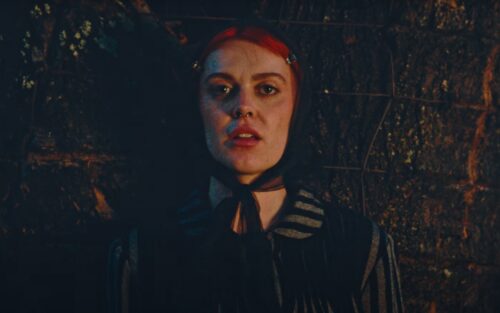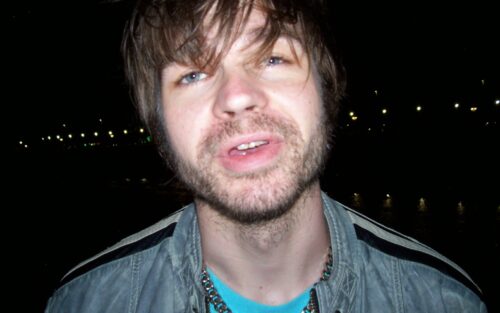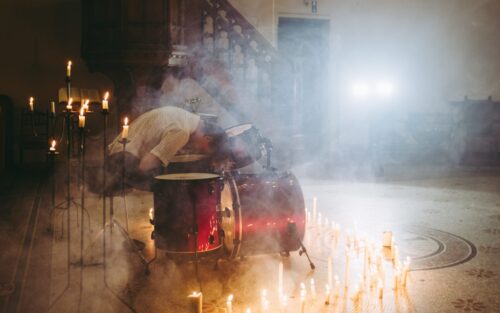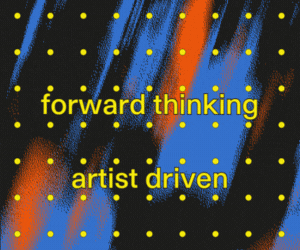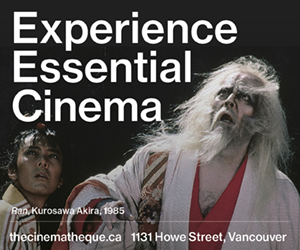Third Eye Blind Is Dancing Again
Guitarist Kryz Reid unravels the deep meaning behind new album, Our Bande Apart.
By Yasmine Shemesh
- Published on
The Godard film also inspired Third Eye Blind’s new album, Our Bande Apart, serving as a jumping off point for its art and aesthetic. It is referenced in the title, of course, and the dance is depicted on the cover, showing three women in motion (the one in the middle even sporting a fedora like Karina does). An upcoming music video for the record’s opening track, “Goodbye to the Days of Ladies and Gentlemen,” is the most direct representation of that inspiration, Kryz Reid, the band’s guitarist, tells RANGE. Frontman Stephan Jenkins filmed it in New York with David Wexler, who directed the group’s 2020 documentary Motorcycle Drive By.
Our Band Aparte makes obvious parallels to the pandemic, as well, with the past year and a half quite literally keeping the Bay Area fivesome from each other. In March of last year, Third Eye Blind flew to Seattle to kick off their Screamer Part 2 Tour. Reid remembers walking around with his bandmates, the city feeling empty and eerie like a ghost town. The show was inevitably pulled and the band drove down to Portland for their next gig. By morning, the entire tour was cancelled. It felt like the beginning of a fight, Reid describes. All the anticipation, being in the ring, fists up ready to go, and then, at the ding of the bell, it’s called off. Surreal.
Despite the ensuing lockdowns, Third Eye Blind kept incredibly busy. They recorded So Alone, So Alive, a four-song benefit EP with proceeds going to a relief fund for live touring crews. (“Everybody just picked up their practice amps, counted to four and pressed record,” Jenkins told SPIN.) They continued the podcast that they started in late 2019, Pod of Wine, virtually. They released Motorcycle Drive By, unpacking the story behind one of their most enduring tracks. Featured on their smash 1997 self-titled debut, alongside era-defining hits like “Semi-Charmed Life,” “Jumper,” and “How’s It Going to Be,” “Motorcycle Drive By” became a cult favourite over the years, its longevity spurred by soulful songwriting that hits right in the guts and the imprint it left on the lives of their fans. And then, finally, the band got back together. Our Bande Apart was recorded in Eagle Rock, California and comes with a companion documentary, How We Hold Each Other Right Now: The Making Of Our Bande Apart, which Reid directed, that captures the experience inside the studio.
When we connect, Third Eye Blind is heading to Toledo, Ohio for a show. Reid is speaking over the telephone from an airport in Los Angeles, getting ready to check into his flight. There is a lightness to his voice as he reflects on the past year and how the band continued to propel forward. “It just made us appreciate more what the whole thing is, you know?” Reid says. “I remember years ago, we were on tour, and [drummer Brad Hargreaves] brought a practice kit and he had it set up in the back lounge of our tour bus. I was sitting there with the guitar, jamming, and he was playing on his drums. And I made a gym analogy, like, you’re puttin’ in the hours, bro! You’re puttin’ in the work! And he turned around and said, ‘You never know when your last gig is going to be. My last gig is gonna be good.’ It just always stuck with me. It’s just that mindset.”
In lockdown, Jenkins’ mindset became laser focused. He channeled his pandemic frustrations into songwriting, resulting in an enormous rush of creativity that informed the majority of the new record. When it came time for Eagle Rock, Jenkins was more prepared than he’d ever been. “Usually he turns up and he’s got the bones of everything and then we start to flesh it all out, depending on what we’ve been doing beforehand,” Reid says. “He was like, ‘I’ve got this song and this song and this song,’ and so it was just a breeze, the recording sessions. We were way ahead of ourselves.” They were basically finished, Reid says, with three more weeks left in the studio.
That spiritedness underscores Our Bande Apart: the album has an intricate post-punk landscape that moves and shifts and morphs—hopeful and bright in places, melancholic and reflective in others, anchored by the rhythm of poetic lyricism and sharp musicianship. There’s “Again,” a blissed-out jam featuring Best Coast’s Bethany Cosentino, one of a few great collaborations on the record. “Dying Blood,” which gradually builds as it mines what feels like post-pandemic anxiety: “Can you tell me how to be friends without being exhausted?” Jenkins implores. Then, “To The Sea,” an experimental ballad with glitchy textures that create a beautiful haunting quality. Featuring background vocals from Velvet Negroni, it was produced by Ryan Olson of Poliça and Marijuana Death Squad. “He’s a lunatic,” Reid jokes, laughing, “but he’s amazing. He takes songs and deconstructs them.” Jenkins sent his demo to Olson, who returned it in time for the band’s first day in the studio. “We all listened to it and we’re like, that’s done. We didn’t touch it.”


Another standout moment is “Funeral Singers,” a cover of electro-pop duo Sylvan Esso’s 2018 track that takes the original easygoing indie vibe and transforms it into vibrant technicolour. It starts with a psychedelic backwards guitar solo from Reid—he has another midway through the song, too—which is something, he says, he’s always wanted to do on a record. He performed it in one live take. “We did it on a song called ‘Don’t Give In’ before, but we did that as an overdub the way Jimi Hendrix did back in the day. But for ‘Funeral Singers,’ I wanted to play a backwards guitar solo live in the room with the guys, so I worked out how to do that with a Strymon Timeline [delay pedal], playing a beat ahead of the rest of the guys. When you see that footage in the documentary, you’ll see how my guitar playing looks out of sync—it’s not, that’s just what playing a backwards guitar solo live looks like!”
Smashing Pumpkins guitarist Jeff Schroeder also plays on “Funeral Singers.” “He’s been a mate of ours for several years,” Reid adds. “Daniel Nolan [Third Eye Bind’s photographer] introduced us years ago, they’ve been mates since before Jeff was a Pumpkin. Stephan’s idea was to have a Thin Lizzy double guitar player feel on the track. Jeff’s a gem, lovely dude.”
“Dust Storm,” though, holds extra significance for Reid. He describes the song as being redemptive, kind of sad yet joyful, sonically channelling The Cure. “I was actually just talking to Stephan about it 20 minutes ago, on the way to the airport here,” he says. Jenkins had this whole analogy, Reid begins, of the past year being like a dust storm: you couldn’t see what was coming next, everyone was confused, good information was difficult to find. It made Jenkins think about Mars and how life is this rare and extraordinary thing—something the pandemic also highlighted. “And then, at the exact same time as all of this, I had a little baby boy coming,” Reid continues, audibly smiling. His son is three months old now. “So it was particularly and poignantly in focus for me, you know, because the preciousness of life is something to think about when you’ve got a baby coming.”
The companion documentary takes its name from a line in “Dust Storm”: “the only thing I know is how we hold each other right now.” It’s a lyric that really drives home the whole record, Reid maintains. He shoots the band often while on the road, and, for this film, he set up cameras around the studio in unassuming places and just let them run. The approach serves to capture a spontaneous authenticity. “I shed a tear at the heart of this documentary,” Reid posted on Instagram, shortly after this conversation. “Loud and unabashed love.” It’s clear that, for the band, love really emerged as the emotional core of the entire project—love for their craft and for each other. Gratitude for both.
Reid remembers the first time Third Eye Blind performed together again after the pandemic set in, after they’d been apart for months. It was a drive-in concert in Ventura, between San Francisco and L.A. There was a big round stage set up in a parking lot, with cars assembled around it. A bursting feeling of anticipation and excitement floated in the air. Relief. The audience felt it, too. “We were all just beaming at each other and laughing out loud at everything that it was to be back onstage,” Reid says. As the show went on, the band circled the platform over and over again in enthusiasm. They were dancing.
By Stephan Boissonneault
Nate Amos revisits a decade of stray ideas and turns them into his most compelling record yet.
By Khagan Aslanov
Mike Wallace’s electro-punk project premieres the hypnotic, percussion-driven video for "Certain Days."

